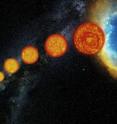Brightness variations of sun-like stars: The mystery deepens
"Astronomers are left in the dark, and for once, we do not enjoy it," says Christine Nicholls from Mount Stromlo Observatory, Australia, lead author of a paper reporting the study. "We have obtained the most comprehensive set of observations to date for this class of Sun-like stars, and they clearly show that all the possible explanations for their unusual behaviour just fail." The mystery investigated by the team dates back to the 1930s and affects about a third of Sun-like stars in our Milky Way and other galaxies. All stars with masses similar to our Sun become, towards the end of their lives, red, cool and extremely large, just before retiring as white dwarfs. Also known as red giants, these elderly stars exhibit very strong periodic variations in their luminosity over timescales up to a couple of years.
"Such variations are thought to be caused by what we call 'stellar pulsations'," says Nicholls. "Roughly speaking, the giant star swells and shrinks, becoming brighter and dimmer in a regular pattern. However, one third of these stars show an unexplained additional periodic variation, on even longer timescales — up to five years."
In order to find out the origin of this secondary feature, the astronomers monitored 58 stars in our galactic neighbour, the Large Magellanic Cloud, over two and a half years. They acquired spectra using the high resolution FLAMES/GIRAFFE spectrograph on ESO's Very Large Telescope and combined them with images from other telescopes [1], achieving an impressive collection of the properties of these variable stars.
Outstanding sets of data like the one collected by Nicholls and her colleagues often offer guidance on how to solve a cosmic puzzle by narrowing down the plethora of possible explanations proposed by the theoreticians. In this case, however, the observations are incompatible with all the previously conceived models and re-open an issue that has been thoroughly debated. Thanks to this study, astronomers are now aware of their own "ignorance" — a genuine driver of the knowledge-seeking process, as the ancient Greek philosopher Socrates is said to have taught.
"The newly gathered data show that pulsations are an extremely unlikely explanation for the additional variation," says team leader Peter Wood. "Another possible mechanism for producing luminosity variations in a star is to have the star itself move in a binary system. However, our observations are strongly incompatible with this hypothesis too."
The team found from further analysis that whatever the cause of these unexplained variations is, it also causes the giant stars to eject mass either in clumps or as an expanding disc. "A Sherlock Holmes is needed to solve this very frustrating mystery," concludes Nicholls.
Source: ESO
Other sources
- Brightness variations of sun-like stars: The mystery deepensfrom Science DailyWed, 9 Dec 2009, 4:21:20 UTC
- Star data contradicts theoriesfrom Science AlertTue, 8 Dec 2009, 15:21:19 UTC
- Mystery of Changing Star Brightness Deepensfrom Space.comMon, 7 Dec 2009, 16:49:17 UTC
- Brightness variations of sun-like stars: The mystery deepensfrom Science BlogMon, 7 Dec 2009, 16:14:20 UTC
- Brightness variations of sun-like stars: The mystery deepensfrom PhysorgMon, 7 Dec 2009, 15:28:16 UTC
